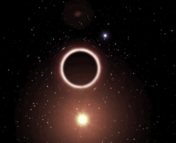Title: Explaining temporal variations in the jet PA of the blazar OJ 287 using its BBH central engine model
Authors: Lankeswar Dey, Mauri J. Valtonen, A. Gopakumar, Rocco Lico, José L. Gómez, Abhimanyu Susobhanan, S. Komossa, and Pauli Pihajoki
First author’s institution: Department of Astronomy and Astrophysics, Tata Institute of Fundamental Research, Mumbai 400005, India
Journal: Submitted to MNRAS, pre-print available on the arXiv
A blazar is a special type of active galactic nucleus (AGN) that has a relativistic jet pointing toward Earth. As described in our “Guide to Classification of Galaxies & AGN,” an AGN is a supermassive black hole (SMBH) that has a superheated accretion disc around it. AGN are always found in the centers of galaxies and account for most of the extragalactic gamma ray sources. AGN will usually have a relativistic jet, but the observed properties of the AGN are very dependent on which way this jet is pointing. When the jet is pointing toward Earth (or toward the observer, as it’s sometimes written), we call this AGN a blazar. The direct cause of this jet is, of yet, unknown, but there are many theories – including one where the center of the AGN is actually a binary black hole (BBH) system, instead of just one SMBH. The source of interest in today’s paper, OJ 287, is the best-known BBH blazar candidate!
Bright Blazar OJ 287
OJ 287 is a bright blazar at redshift, z = 0.306 (~ 3.47 billion years ago). We have optical observations of this source from as early as the 1880s (only ~20 years after the end of the American Civil War), but we only have radio observations from the 1990s & onward. The optical observations show quasi-periodic magnitude variations which are explained (& predicted) very well by this BBH central engine model. In this model, the orbital plane is tilted at an angle to the accretion disc, and brightness flares happen when the secondary black hole passes through the disc. The radio observations of the jet, on the other hand, show large temporal variations in the position angle (PA) within the sky-plane of the jet, sometimes jumping nearly 130°! Today’s paper tries to explain the temporal PA variations through the lens of the BBH central engine model at three separate radio wavelengths, 86 GHz, 43 GHz, and 15 GHz, chosen because they probe different parts of the jet.
Let’s Talk Stats
The authors present two models to explain the PA variations of the radio jet: the spin model & the disc model. In the spin model, the direction of the radio jet is determined by the spin of the primary black hole. In the BBH model for OJ 287, the angular momenta of the spin of the primary BH and the orbit of the BBH system are misaligned, thereby causing the primary BH to precess about the total angular momentum vector. In the other model, the disc model, the radio jet’s PA variations are linked to the angular momentum of the inner region of the accretion disc. In order to establish the parameters for each model (and therefore get an equation to plot to compare to data), the authors use the Bayesian inference technique. Basically, with this technique, in Bayes’ Theorem, shown below, the H represents the model parameter(s), and the E represents the radio observations of the jet. P(E) represents the probability of the data occurring, but is formally used as a normalizing factor. P(H) represents the probability of the model parameter, which is considered “known.” P(E|H) represents the probability of observing the data, E, given the model parameter, H, and P(H|E) represents the opposite.

After comparing both models, the authors found that neither model was preferred! Shown in Figure 1, both models fit the data (until ~2015) equally as well. That said, the authors were able to project their models to make predictions about future PA variations of the primary radio jet, especially those at 86 GHz. The estimates for both models are significantly different at 86 GHz and 43 GHz, thereby allowing us to determine the most favorable model with new observations in the years to come!
Let’s Take a Picture
In 2019, the Event Horizon Telescope (EHT) took the first (and second!) image of a black hole, namely the SMBH at the center of M87. Because of it’s close distance (only ~ 3.96 billion light years away!) and unique jet structure, OJ 287 is a prime candidate for imaging with EHT! Although the two BHs are too close to be distinctly observed with EHT, there’s another reason this source will be so special. The authors predict there will be a secondary jet from the secondary black hole that will be visible, and, most notably, pointing in a complete other direction than the primary jet (~ 60° separation, as shown in Figure 2)! This means that in the EHT image, we’d be able to see two jets which would almost absolutely confirm the BBH model. An image like this would be the first of its kind, and goes to show that the future of black hole astronomy is blazingly bright!
Astrobite edited by: Pratik Gandhi
Featured Image Credit: NASA/JPL




